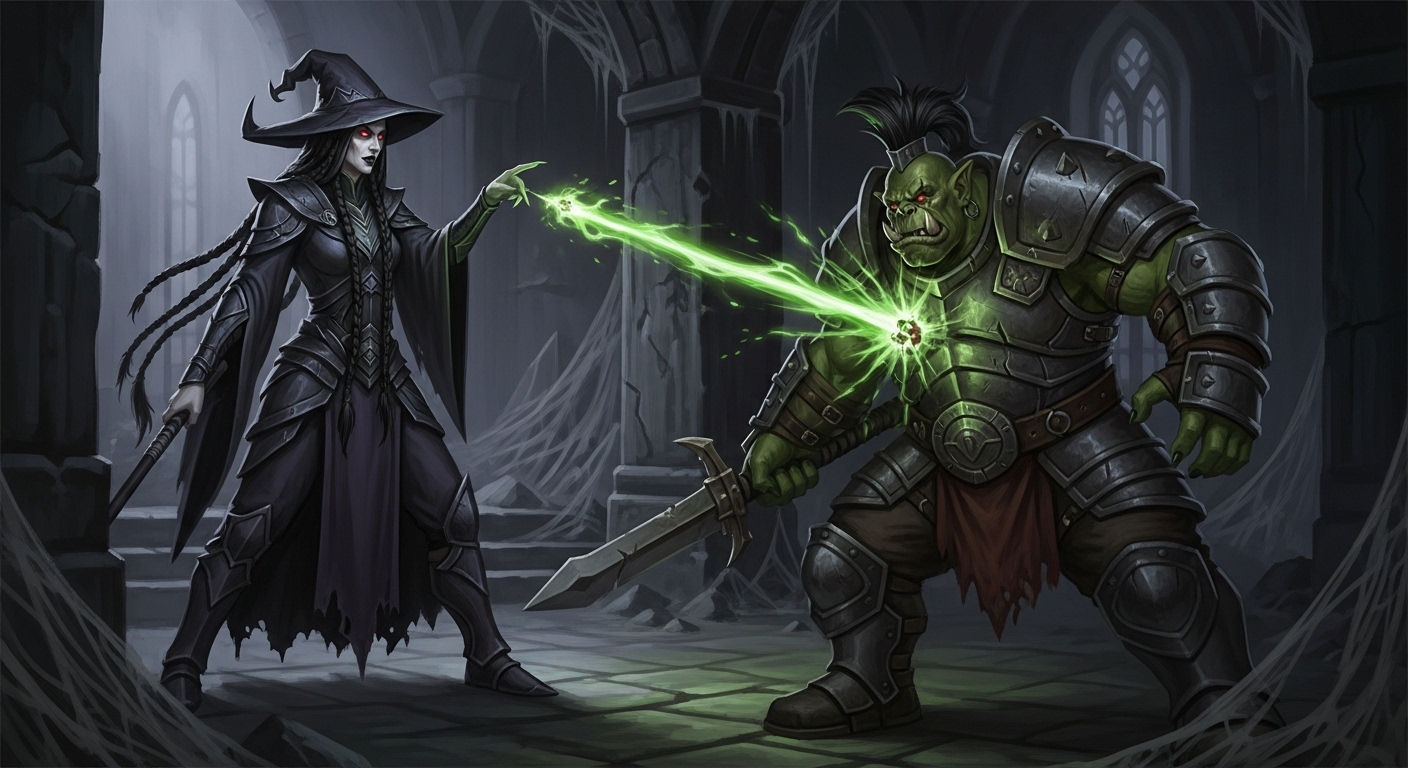Ray Of Enfeeblement

- Level: 2
- School: Necromancy
- Class: Warlock, Wizard
- Casting Time: Action
- Range: 60 feet
- Components: V, S
- Duration: Concentration, up to 1 minute
A beam of enervating energy shoots from you toward a creature within range. The target must make a Constitution saving throw. On a successful save, the target has Disadvantage on the next attack roll it makes until the start of your next turn.
On a failed save, the target has Disadvantage on Strength-based D20 Tests for the duration. During that time, it also subtracts 1d8 from all its damage rolls. The target repeats the save at the end of each of its turns, ending the spell on a success.
Tactical Usage
Dual-Threat Debuffing. Ray of Enfeeblement provides both attack disadvantage and damage reduction against Strength-based enemies, making it excellent for weakening melee threats and heavy hitters.
Sustained Control Effect. The concentration duration with repeated saves creates potential for extended enemy weakening while providing regular escape opportunities through save mechanics.
Versatile Targeting Options. The spell affects Constitution saves but targets Strength-based capabilities, making it useful against a wide range of physically-oriented enemies.
Spell Combinations
Physical Debuff Synergy. Combining with other effects that target movement, armor class, or physical capabilities creates comprehensive anti-melee strategies.
Concentration Protection. Pairing with defensive spells or positioning effects helps maintain the debuff against dangerous enemies who might target the caster.
Follow-Up Coordination. Party members can exploit the reduced damage output and disadvantaged attacks through focused targeting and tactical positioning.
Material Component Details
Component-Free Advantage. Ray of Enfeeblement requires no material components, making it accessible and repeatable without resource constraints or preparation concerns.
Range Effectiveness. The 60-foot range provides safe casting distance while maintaining accuracy for single-target debuffing applications.
Concentration Investment. The spell requires concentration but provides sustained debuffing that justifies the ongoing magical focus investment.
Creator Notes
Melee Enemy Control. Ray of Enfeeblement provides excellent tools for reducing the threat level of powerful physical enemies without completely incapacitating them.
Graduated Effects. The spell provides different levels of effectiveness based on save results, creating dynamic encounters with varying degrees of enemy weakening.
Save-Based Counterplay. Regular save opportunities prevent permanent debuffing while maintaining pressure on affected enemies.
Environmental Interactions
Line of Effect Requirements. Standard ranged spell targeting rules apply, requiring clear paths to targets within the 60-foot range limitation.
Strength-Based Activity Impact. The debuff affects all Strength-based activities including athletics, melee attacks, and Strength-based damage regardless of combat status.
Damage Reduction Universality. The 1d8 damage reduction applies to all damage rolls, not just Strength-based damage, creating broader defensive benefits.
Common Rulings & Clarifications
Save Timing Mechanics. Targets make Constitution saves initially and at the end of each turn, with success ending the effect immediately.
Strength Test Scope. Disadvantage applies to all Strength-based d20 tests including attacks, skill checks, and ability checks using Strength.
Damage Reduction Application. The 1d8 reduction applies to all damage rolls made by the target, calculated before applying damage to hit points.
Successful Save Benefits. Even successful initial saves provide tactical benefit through disadvantage on the next attack roll until the caster's next turn.
Alternative Applications
Non-Combat Weakening. Reducing enemy effectiveness during skill challenges, contests of strength, or physical competitions outside direct combat.
Interrogation Support. Weakening physically intimidating subjects might make them more cooperative or less threatening during questioning.
Crowd Control Assistance. Reducing the damage output of dangerous enemies allows parties to manage multiple threats more effectively.
Related Spells
Debuff Magic Comparison. Hold Person provides complete incapacitation, while Slow affects multiple targets, and other debuff spells target different capabilities.
Necromancy School. Chill Touch, Inflict Wounds, and other necromancy spells share themes of weakening and harming enemies through life force manipulation.
Strength Targeting. Few spells specifically target Strength-based activities, making Ray of Enfeeblement unique in its approach to physical debuffing.
Scaling Analysis
Consistent Utility Value. Ray of Enfeeblement maintains effectiveness throughout character progression as physical threats continue posing dangers regardless of level.
Resource Efficiency. The spell provides excellent value for a 2nd-level slot when facing powerful melee enemies or physically-oriented threats.
Campaign Integration. Utility scales with physical threat frequency and strength-based enemy prevalence in specific encounters and campaign types.
Narrative Flavor
Energy Drain Manifestation. The spell should emphasize the draining of physical vitality and strength, with visible effects of weakness and reduced vigor.
Necromantic Corruption. The beam can be described as sapping life force, corrupting physical power, or introducing weakness through magical energy manipulation.
Gradual Weakening. The ongoing effects should reflect continuous sapping of strength and vigor, with targets appearing progressively more enfeebled and drained.